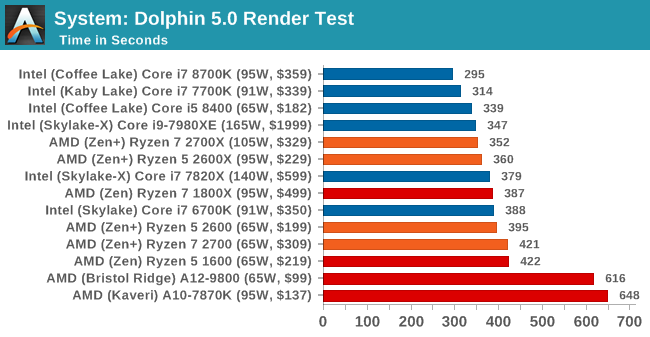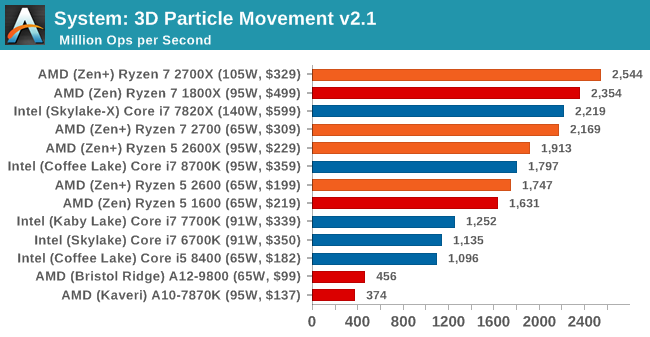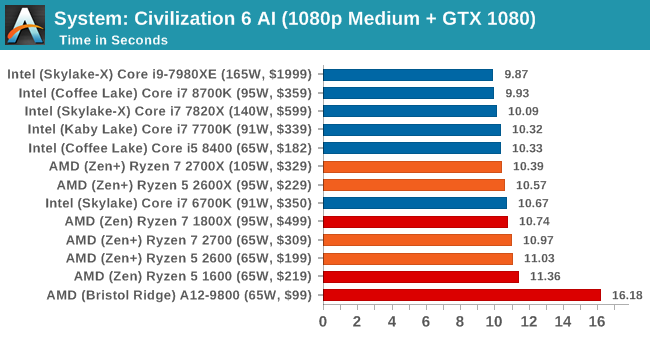The AMD 2nd Gen Ryzen Deep Dive: The 2700X, 2700, 2600X, and 2600 Tested
by Ian Cutress on April 19, 2018 9:00 AM ESTCPU System Tests
Our first set of tests is our general system tests. These set of tests are meant to emulate more about what people usually do on a system, like opening large files or processing small stacks of data. This is a bit different to our office testing, which uses more industry standard benchmarks, and a few of the benchmarks here are relatively new and different.
All of our benchmark results can also be found in our benchmark engine, Bench.
FCAT Processing: link
One of the more interesting workloads that has crossed our desks in recent quarters is FCAT - the tool we use to measure stuttering in gaming due to dropped or runt frames. The FCAT process requires enabling a color-based overlay onto a game, recording the gameplay, and then parsing the video file through the analysis software. The software is mostly single-threaded, however because the video is basically in a raw format, the file size is large and requires moving a lot of data around. For our test, we take a 90-second clip of the Rise of the Tomb Raider benchmark running on a GTX 980 Ti at 1440p, which comes in around 21 GB, and measure the time it takes to process through the visual analysis tool.

FCAT is a purely single threaded task, and it takes benefits from the top frequency parts and high IPC from Intel. On the AMD front, the Ryzen 5 parts are scoring better than the Ryzen 7 parts, but are within an error margin.
Dolphin Benchmark: link
Many emulators are often bound by single thread CPU performance, and general reports tended to suggest that Haswell provided a significant boost to emulator performance. This benchmark runs a Wii program that ray traces a complex 3D scene inside the Dolphin Wii emulator. Performance on this benchmark is a good proxy of the speed of Dolphin CPU emulation, which is an intensive single core task using most aspects of a CPU. Results are given in minutes, where the Wii itself scores 17.53 minutes (1052 seconds).

Dolphin is also a single threaded test, and has historically had benefits on Intel CPUs. The new Ryzen-2000 series, with extra IPC and frequency, are pushing ahead of Intel's Skylake parts.
3D Movement Algorithm Test v2.1: link
This is the latest version of the self-penned 3DPM benchmark. The goal of 3DPM is to simulate semi-optimized scientific algorithms taken directly from my doctorate thesis. Version 2.1 improves over 2.0 by passing the main particle structs by reference rather than by value, and decreasing the amount of double->float->double recasts the compiler was adding in. It affords a ~25% speed-up over v2.0, which means new data.

For this multi-threaded test, the new 8-core Ryzen 7 2700X pulls further head of Intel's 8-core Skylake-X compared to the 1800X. At six cores however, the Coffee Lake i7-8700K is sandwiched between the Ryzen 5 2600X and Ryzen 5 2600.
Agisoft Photoscan 1.3: link
Photoscan stays in our benchmark suite from the previous version, however now we are running on Windows 10 so features such as Speed Shift on the latest processors come into play. The concept of Photoscan is translating many 2D images into a 3D model - so the more detailed the images, and the more you have, the better the model. The algorithm has four stages, some single threaded and some multi-threaded, along with some cache/memory dependency in there as well. For some of the more variable threaded workload, features such as Speed Shift and XFR will be able to take advantage of CPU stalls or downtime, giving sizeable speedups on newer microarchitectures.

Photoscan is a variable threaded test, and time improvement from the 1800X to the 2700X shows the extra TDP and Precision Boost 2 can literally shave minutes from a test. Intel's slower mesh architecture of Skylake-X on the 8-core 7820X compared to the ring architecture of the Coffee Lake 8700K means that the two fewer cores on the 8700K allows them to draw level, but they are still four minutes or so behind the Ryzen 7 2700X. The big 18-core Intel CPU, the i9-7980XE, is needed to win here.
Civilization6 AI Test
Our Civilization AI test uses the steam version of Civilization 6 and runs the in-game AI test to process 25 rounds of an example end-game. We run the benchmark on our GTX 1080 at 1080p Medium to ensure that rendering is not a limiting factor, and the results are given as the geometric mean of the 25 rounds in the test, to give the average time to process one round of AI.

Parts of the AI test can use multiple threads, however the extra single core performance on Intel does push those parts into the lead.










545 Comments
View All Comments
peevee - Thursday, April 26, 2018 - link
I mean, Octane test in Chrome is what V8 javascript compiler does. And it itself is build with MSVC AFAIR.Dragonstongue - Thursday, April 26, 2018 - link
just looking back at this, you say according to title 2700x-2700-2600x-2600 and yet in most tests are only listing the results for 2700x-2600x..not good for someone really wanting to see the differences in power use or performance comparing them head to head sort of speak.seems the 2700 would be a "good choice" as according to the little bit of info given about it, it ends up using less power than the 2600 even though rated same TDP with 2 extra core 4 extra threads O.O
I do "hope" the sellers such as amazon at least for us Canadian folk stick closer to the price they should be vs tacking on $15-$25 or more compared to MSRP pricing, seems if one bought them same day of launch pricing was right where it should be.
1600 has bounced around a little bit whereas 1600x is actually a fair price compared to what it was "very tempting" though the lack of a boxed cooler is not good.....shame 2600 only comes with wraith stealth instead of spire seeing as the price is SOOO close (not to mention at least launch price vs what the 1xxx generation is NOW, AMD should have been extra nice and bundled the wraith spire for 2600-2600x and wraith LED and wraith max or whatever for the 2700-2700x
I would imagine if they decide to do a 4 core 8 thread 2xxx that would be the spot to use the wraith spire (less heat load via less cores type deal)
29a - Thursday, April 26, 2018 - link
Not trying to be sarcastic but will this article be finished? I really wanted to read the storage and chipset info. If the article is as complete as it is going to get please let us know, 20 year reader asking.John_M - Saturday, April 28, 2018 - link
I'm sure it will be finished one day but I agree that it doesn't seem so at the moment. If you want to find out about StoreMI AMD has a page about it: https://www.amd.com/en/technologies/store-miET - Tuesday, May 1, 2018 - link
I think we've got ourselves a race: which will get here first, the missing parts of the 2nd gen Ryzen review, or new Raven Ridge drivers? Or perhaps hell will freeze first.29a - Friday, May 4, 2018 - link
Sadly it appears as though the article will not be finished. This site was great during about its first 15 years of existence, Purch has done a thorough job of purching it up.jor5 - Tuesday, May 8, 2018 - link
Oh dear what an embarrassing end to this article.Tuck it away under "what was I thinking??" and pretend it never happened.
x0fff8 - Wednesday, May 9, 2018 - link
is this article ever gonna get updated with the new benchmarks?MDD1963 - Thursday, May 10, 2018 - link
And just like that, my 7700K is fast again! :)peevee - Thursday, May 10, 2018 - link
"Technically the details of the chipset are also covered by the April 19th embargo, so we cannot mention exactly what makes them different to the X370 platform until then"That was written for the article published April 19th, and as of May 10th STILL in the text.